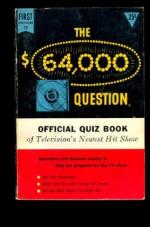|
This section contains 222 words (approx. 1 page at 300 words per page) |
During the 1950s, game shows were television's most popular fare, and The $64,000 Question (1955-58) was unquestionably America's favorite game show. Every Sunday night, the country came to a stop as millions of households tuned in to watch. The premise behind the show was brilliant—in addition to a profession or vocation, many people have hobbies or avocations about which they are remarkably well informed. The show featured contestants such as a jockey who was an art expert, or a psychologist—the young Dr. Joyce Brothers—who loved prize fighting. Players entered an isolation booth and answered questions, working their way up each week to the final $64,000 Question. Unbeknownst to the viewers and, indeed, to some of the contestants, however, the producers of the show were giving answers to the more charismatic players. A few years later, The $64,000 Question came under scrutiny during the investigation by the U.S. Congress known as the Quiz Show Scandal. When the public learned the truth about the "fixed" quiz shows, game shows fell out of favor for years and the American television audience adopted a cynicism that has permeated popular culture ever since.
Further Reading:
Delong, Thomas. Quiz Craze: America's Infatuation with Game Shows. New York, Praeger, 1991.
Holms, John Pynchon, et al. The TV Game Show Almanac. New York, Chilton Book Co., 1995.
|
This section contains 222 words (approx. 1 page at 300 words per page) |


